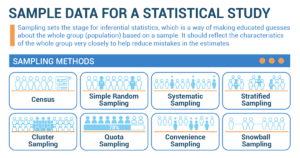Have you ever taken a quick photo of a vast landscape like the Grand Canyon – that’s what sampling is like.

Even this panorama does not capture all of the Grand Canyon, but it allows us to make an educated guess about what we cannot see. In statistics, sampling allows us to make an educated guess about an entire group based on a smaller part we can more easily study. Sampling helps us save time and money while still getting information that we can use to understand the whole group better. Let’s uncover the secrets of sampling together!
What is Sampling?
Sampling is a clever shortcut: Just like capturing a quick snapshot, sampling makes collecting data easier, faster, and cheaper. Instead of trying to ask every person in the world a question (which would be impractical), we turn to sampling as our go-to method when studying everyone in a group isn’t possible.
A well-chosen sample is like a mirror: A carefully selected sample reflects the characteristics of the whole group very closely. It helps us reduce mistakes in our estimates about the entire group, known as the population.
Sampling sets the stage for inferential statistics: Once we have our sample, we can make educated guesses about the whole group using inferential statistics. It’s like solving a puzzle – the sample provides us with clues to understand the larger picture.

Sampling Methods
Census: Everyone counts
Think of a census like a roll-call where you collect data from everyone in the group, known as the population. A census shines when it’s possible and practical to include everyone in your study. For example, if you were investigating the favorite ice cream flavors of all students in your school, conducting a census would involve asking each and every student for their preferred flavor.
- Benefits: A census counts everyone in a population, giving us accurate information about everyone. We can learn about the whole group and make precise conclusions.
- Limitations: Doing a census takes a lot of time, money, and effort. It can be hard to reach everyone or get them to answer all the questions.
Simple random sampling: Lucky draw
Imagine picking names out of a hat. That’s exactly what simple random sampling is like. In this method, each member of the group has an equal chance of being selected. Simple random sampling works best when everyone in your group is pretty much alike or homogeneous. For instance, if you wanted to know the average height of students in your school, you could randomly select a group of students and measure their heights.
- Benefits: Simple random sampling gives everyone an equal chance to be chosen for the sample. It’s fair and helps avoid bias in the selection process.
- Limitations: Simple random sampling might not show the differences between smaller groups in the population. We might miss important details about specific parts of the group.
Systematic sampling: Step by step
Systematic sampling is like playing hopscotch with your data. You select every ‘nth’ member in your population. This method is simple and effective, especially for large groups. Let’s say you wanted to investigate the reading habits of students in your school. You could select every 5th student from the school’s register and survey them about their reading preferences.
- Benefits: Systematic sampling is easy to do and doesn’t require random numbers. It works well when there is a pattern or order in the population.
- Limitations: If there is a hidden pattern in the population, systematic sampling might give us the wrong results. It might not capture everyone’s differences if they don’t fit the pattern.
Stratified sampling: Group and choose
Stratified sampling is like sorting your group into smaller teams or ‘strata’ and picking from each one. This method is handy when your group is varied or heterogeneous. Suppose you wanted to understand the opinions of students in your school regarding extracurricular activities. You could divide the students into different grade levels (strata) and randomly select a few students from each grade to represent their opinions.
- Benefits: Stratified sampling helps us include different groups or types of people in our sample. We can learn about each group separately and get more accurate information.
- Limitations: Stratified sampling takes time and planning because we need to know about the different groups in the population. It might not show us all the differences within each group.
Cluster sampling: A slice of the pie
Imagine your group is a large pizza spread across a wide area. Cluster sampling is when you take a few ‘slices’ (clusters) to study. This method is ideal when the group is large and geographically dispersed. For instance, if you wanted to investigate the pollution levels in your city, you could randomly select a few neighborhoods (clusters) and measure the air quality in each of them.
- Benefits: Cluster sampling is good when people are spread out or grouped together in certain areas. It saves time and effort by selecting groups instead of individuals.
- Limitations: Cluster sampling might not give us the same level of accuracy as other methods. We might miss out on the differences between individuals within each group.
Quota sampling: Meeting targets
Quota sampling is like setting a goal. Let’s say you wanted to interview 10 people from each age group to understand their preferences for video games. You would make sure you reach your target by selecting participants from each age group until you meet the quota. This method ensures you get a certain amount of data from different segments of your group.
- Benefits: Quota sampling lets us choose a specific number of people from different groups. We can make sure our sample represents the diversity in the population.
- Limitations: Quota sampling relies on the researcher’s judgment, which can introduce bias. It might not capture all the differences within each group.
Snowball sampling: Friend of a friend
Snowball sampling involves asking a friend, who asks a friend, and so on, to participate in your study. This method is often used when you have a hard-to-reach population. Suppose you wanted to understand the social media habits of teenagers in your city. You could start by surveying a few teenagers you know and then ask them to recommend other participants. This way, the network of participants grows like a snowball rolling down a hill.
- Benefits: Snowball sampling helps us study people who are hard to reach or find. We can learn about hidden or rare groups by asking participants to refer others.
- Limitations: Snowball sampling might not give us a complete picture of the whole population. The people referred by participants might have similar characteristics, so we might miss out on other perspectives.
Case Study: Sampling for a Statistical Study on Space
 Lily has a project where she wants to find out what other students think about space exploration and what they know about planets and stars. However, interviewing every student is impossible, so Lily decides to use sampling, a clever way to collect data for her statistical study. Let’s see how she goes about it.
Lily has a project where she wants to find out what other students think about space exploration and what they know about planets and stars. However, interviewing every student is impossible, so Lily decides to use sampling, a clever way to collect data for her statistical study. Let’s see how she goes about it.
Lily knows she can’t talk to everyone, so she uses sampling. Sampling means choosing a smaller group, called a sample, from a bigger group, like her schoolmates. By asking questions to this sample, Lily can get a good idea of what all the students in her school think about space. It saves her time and still gives her important information.
Lily needs to decide how she will pick her sample. There are different ways to do this, and Lily chooses two methods that work well together:
Random Sampling: Lily decides to use random sampling as her main method. She numbers all the students in her school and picks some numbers randomly. That way, every student has an equal chance of being selected. This helps avoid any favoritism or bias, and it gives a fair representation of what all the students think about space.
Stratified Sampling: Lily also wants to make sure that her sample represents students from different grade levels. So, she uses stratified sampling. She divides her schoolmates into groups based on their grade levels, like 6th grade, 7th grade, and 8th grade. Then, she randomly chooses some students from each group. This way, she ensures that students from all grade levels are included in her study.
Once Lily has her sample, she starts collecting data by asking questions. She creates a survey with questions about space exploration, planets, and stars. Lily gives the survey to the selected students and gives them enough time to answer the questions thoughtfully. She also promises to keep their answers private and anonymous so everyone feels comfortable sharing their thoughts.
By using random sampling and stratified sampling methods, Lily collects a good sample that represents what all the students in her school think about space. This helps her understand their opinions and knowledge. With this information, Lily can draw conclusions about the whole school population, even though she didn’t talk to every student.